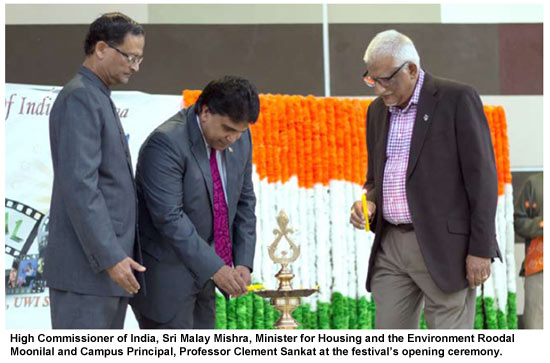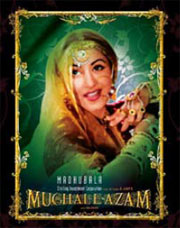 |
 |
 |
|
March 2013 |
It started in 2010 with the launch of the Indian Cine-Club, a series of regular film screenings, and later, the Indian Film Festival. The Tagore Film Festival in 2012 celebrated the life and work of Rabindranath Tagore, one of India’s national icons. This year, which marks 100 years of film production in India, afforded another way to deepen the relationship, and so, for one week, from January 27, a series of award-winning Indian films were shown at the campus. Dr Christopher Meir, coordinator of the Film Programme, said he was happy to continue working with the High Commission’s cultural division, the Mahatma Gandhi Institute for Cultural Cooperation. “This relationship has once again helped to establish a place for Indian cinema on the St. Augustine Campus and afforded the public the opportunity to see and learn about some of the many masterpieces of Indian cinema,” he said. The film festival’s opening ceremony featured speeches from the Campus Principal, Professor Clement Sankat, High Commissioner of India, Sri Malay Mishra and the Minister for Housing and the Environment Roodal Moonilal. This ceremony, which was also to mark India’s Republic Day, was followed by a screening of the classic Hindi film Mughal E-Azam. The selected films came from all parts of India and from different decades, and were meant to give the Campus community a deeper sense of the complexity and distinct achievement that is Indian cinema. Each of the films had won several National Film Awards in India, with a few capturing an international audience in some of the world’s most prestigious film festivals.
Rat Trap (Adoor Gopalakrishnan) is often hailed as the director’s best work, winning awards for the Most Original and Imaginative Film from the British Film Institute, the Sutherland Trophy from the London Film Festival as well as the Silver Lotus Award for Audiography and Best Regional Film (Malayam) at the National Film Awards in 1982. The film toured a number of film festivals around the world including Cannes International Film Festival in 1982. Gopalakrishnan, a pioneering figure, is often credited with revolutionizing the Malayalam film industry, as he established the first film society in Kerala, Chitralekha Film Society, which influenced an entire film movement in Kerala. Deewar, which stars Amitabh Bachchan, is the epitome of the angry-young-man film, which explores a tumultuous time in India’s history. Directed by Yash Chopra, Deewar boasts seven Filmfare Awards with an additional two nominations. The film was selected in part to celebrate the life and work of Chopra, one of the towering figures of Hindi cinema who passed away recently at the age of 80. Mahanagar, by India’s most internationally acclaimed director, Satiyajit Ray, received the Silver Bear for Best Director at the 14th Berlin International Film Festival. Ray is best known for his trilogy about the character Apu, which began the tradition of ‘parallel cinema’ within India. Filming in Calcutta, and in the Bengali language, Ray inspired a wave of regional cinemas across India to compete with Bollywood. A film about cricket, Iqbal (Nagesh Kukunoor) won the National Film Award for Best Film on Other Social Issues. Iqbal was one of the highest-grossing low budget films when it was released in 2005. Time Magazine has listed Nayagan, which was directed by Mani Ratnam, in 2005 as one of the All-Time 100 Best Films list. It also received the National Film Award for Cinematography, Art Direction and the Best Actor Award for Kamal Hasaan. Nayagan is the only Tamil language film on this list and easily one of the most acclaimed made in this South Indian language. The film was India’s official entry to the Oscars for Best Film in a Foreign Language in 1987. Ratnam, the film’s director is widely credited with altering the profile of Indian cinema, bringing international attention to the Tamil film industry. The most recent film featured, Kahani was made in 2012 and was co-produced and co-written by its director Sujoy Ghosh. So far, at the Filmfare Awards, Kahani has captured five awards including best Director and Best Actress for Vidya Balan. Shot in Calcutta, the film tells the tale of a pregnant woman (Balan) who is searching for her missing husband in the middle of the Durga Puja festivities. The festival was a huge success, said Dr Meir, and there is more to come. “We look forward to the re-launch of the Indian Cine-Club in 2013 and continuing to team with our friends in the High Commission to enhance cultural and artistic understanding of India within the Caribbean,” he said. (Dainia Wright) The Club launched its bi-weekly series with films every other Thursday at 5pm at the School of Education’s auditorium. The next scheduled ones are on April 4 – Pinjar, April 18 – Amar Akbar Anthony, and May 2 – Rocket Singh. |



 The opening film, Mughal-e-Azam received numerous nominations at the 1961 staging of the Filmfare Awards, eventually winning awards for Best Feature Film, Best Cinematography and Best Dialogues. It also received the award for Best Feature Film in Hindi at the National Film Awards in the same year. At the time of its release, Mughal-e-Azam broke the record for highest grossing film in India.
The opening film, Mughal-e-Azam received numerous nominations at the 1961 staging of the Filmfare Awards, eventually winning awards for Best Feature Film, Best Cinematography and Best Dialogues. It also received the award for Best Feature Film in Hindi at the National Film Awards in the same year. At the time of its release, Mughal-e-Azam broke the record for highest grossing film in India.